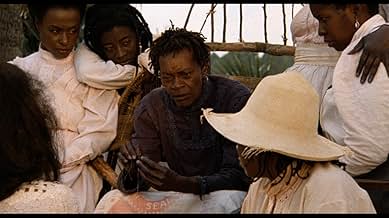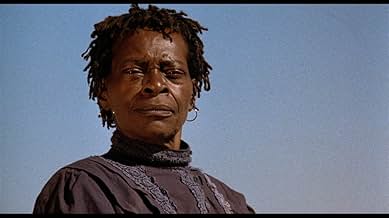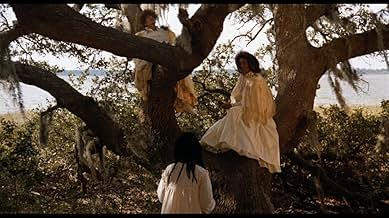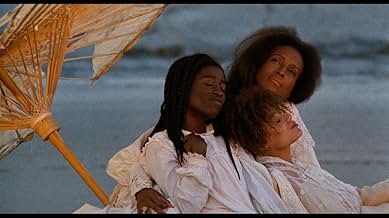VALUTAZIONE IMDb
6,6/10
3650
LA TUA VALUTAZIONE
Aggiungi una trama nella tua linguaA languid, impressionistic story of three generations of Gullah women living on the South Carolina Sea Islands in 1902.A languid, impressionistic story of three generations of Gullah women living on the South Carolina Sea Islands in 1902.A languid, impressionistic story of three generations of Gullah women living on the South Carolina Sea Islands in 1902.
- Regia
- Sceneggiatura
- Star
- Premi
- 4 vittorie e 2 candidature totali
Barbara O
- Yellow Mary
- (as Barbara-O)
Tony King
- Newlywed Man
- (as Malik Farrakhan)
Recensioni in evidenza
Daughters in the Dust is one of those rare movies that truly makes you wonder long and hard about the possibilities of the film form. The film as pure narrative leaves much to be desired; yet it's is not concerned about telling the intricate and sentimental goings-on of one or two human beings; a single tale told in one moment in time. No, the film's scope is much wider and anthropological in scale, thus requires more than just a passing judgment on its entertainment value.
The film concerns itself with the Peazant family; proud members of Gullah creoles who originated from slaves traded along the remote islets of South Carolina and Georgia. Even before the Civil War generations of the Gullah people lived quietly as rice farmers on these islands and thanks in large part to regional isolation they were able to rebuild and retain much of the linguistic, cultural and religious heritage that had been wiped out by the slave trade. By 1901, the Peazants are mulling over the idea of relocating to the mainland.
The film has the narrative distinction of being told from the perspective of an unnamed and unborn member of the Peazants played by Kay-Lynn Warren. At only four, the young Warren peeks through the hole of her family's history only appearing twice herself as a sprite. We meet her pregnant mother Eula (Rogers), her aunts Haagar (Moore), Viola (Bruce) and Yellow Mary (Barbara-O) as well as Nana (Day) the matriarch of the family. Nana is old enough to remember the scourge of slavery and as a result is resonant to move to the mainland. Meanwhile Haagar is the strongest advocate for the move saying "If Nana wants to live and die on this island, then God bless her old soul." Two members of the clan have already moved away; Viola who moved to Philadelphia to become a ardent Christian; and Yellow Mary, who according to Viola is a "wasted woman".
Despite showcasing a family hungry for change and progress, the film gives proper reverence to the traditions of the Gullah people. The most respected people on the island are the elders who consist of Nana and Bilal Muhammad (Abdurrahman) the resident mullah. The spiritual ceremonies of the family relies on a mixture of Christianity, Islam and African animism that gives everything natural around them a lyrical quality. Yet underneath the pleasant depictions of sun-soaked beaches and marshy lowlands the internal conflict behind the eyes of the Peazants can't help but surface during communal gatherings. "We are two people in one body," says Nana as she defies the rest of the family who hope to travel north with their hopes and dreams.
If there is one glaring problem with Daughters of the Dust it's its expectations of the viewer. During production director Julie Dash wanted to keep the authenticity of the people intact and thus had actors speak only in the Gullah dialect and didn't consider subtitles. A minority of audience members may find this tact a mesmerizing exercise in linguistics. A feeling not unlike hearing the warm familiar sounds of your parents speaking while you were a toddler. From a purely anthropological perspective this was the best narrative choice one could hope for, allowing those with patience further rewards with repeated viewings. Unfortunately if you're not one of patience or a strong interest in anthropology or etymology you might find yourself distracted and looking for other stimuli.
There are many ways to read a movie of this nature. Most movies start and end with a graspable narrative, quick and easy explanations to plot details and an clear resolution. Daughters of the Dust doesn't let you off the hook with easy solutions. It instead asks serious questions. Questions that highlight the consequences of modernity's encroachment on tradition, cultural identity, cross-generational turmoil and diaspora. Furthermore the movie gives willing audiences a sense of belonging among the Gullah people; a warmth you seldom feel on the screen. It also does so in a very spirited and exquisite way featuring some of the most lyrical visual storytelling $800,000 can buy.
The film concerns itself with the Peazant family; proud members of Gullah creoles who originated from slaves traded along the remote islets of South Carolina and Georgia. Even before the Civil War generations of the Gullah people lived quietly as rice farmers on these islands and thanks in large part to regional isolation they were able to rebuild and retain much of the linguistic, cultural and religious heritage that had been wiped out by the slave trade. By 1901, the Peazants are mulling over the idea of relocating to the mainland.
The film has the narrative distinction of being told from the perspective of an unnamed and unborn member of the Peazants played by Kay-Lynn Warren. At only four, the young Warren peeks through the hole of her family's history only appearing twice herself as a sprite. We meet her pregnant mother Eula (Rogers), her aunts Haagar (Moore), Viola (Bruce) and Yellow Mary (Barbara-O) as well as Nana (Day) the matriarch of the family. Nana is old enough to remember the scourge of slavery and as a result is resonant to move to the mainland. Meanwhile Haagar is the strongest advocate for the move saying "If Nana wants to live and die on this island, then God bless her old soul." Two members of the clan have already moved away; Viola who moved to Philadelphia to become a ardent Christian; and Yellow Mary, who according to Viola is a "wasted woman".
Despite showcasing a family hungry for change and progress, the film gives proper reverence to the traditions of the Gullah people. The most respected people on the island are the elders who consist of Nana and Bilal Muhammad (Abdurrahman) the resident mullah. The spiritual ceremonies of the family relies on a mixture of Christianity, Islam and African animism that gives everything natural around them a lyrical quality. Yet underneath the pleasant depictions of sun-soaked beaches and marshy lowlands the internal conflict behind the eyes of the Peazants can't help but surface during communal gatherings. "We are two people in one body," says Nana as she defies the rest of the family who hope to travel north with their hopes and dreams.
If there is one glaring problem with Daughters of the Dust it's its expectations of the viewer. During production director Julie Dash wanted to keep the authenticity of the people intact and thus had actors speak only in the Gullah dialect and didn't consider subtitles. A minority of audience members may find this tact a mesmerizing exercise in linguistics. A feeling not unlike hearing the warm familiar sounds of your parents speaking while you were a toddler. From a purely anthropological perspective this was the best narrative choice one could hope for, allowing those with patience further rewards with repeated viewings. Unfortunately if you're not one of patience or a strong interest in anthropology or etymology you might find yourself distracted and looking for other stimuli.
There are many ways to read a movie of this nature. Most movies start and end with a graspable narrative, quick and easy explanations to plot details and an clear resolution. Daughters of the Dust doesn't let you off the hook with easy solutions. It instead asks serious questions. Questions that highlight the consequences of modernity's encroachment on tradition, cultural identity, cross-generational turmoil and diaspora. Furthermore the movie gives willing audiences a sense of belonging among the Gullah people; a warmth you seldom feel on the screen. It also does so in a very spirited and exquisite way featuring some of the most lyrical visual storytelling $800,000 can buy.
Julie Dash grew up in Long Island, New York and graduated from CCNY right after high school with a degree in film production. Dash moved to L.A. only to be rejected by UCLA's film department, but later accepted as a student of the American Film Institute through a fellowship. Grants then started rolling in and Dash was able to begin writing and shooting films which revolved around true historical portrayals and images of African woman such as depicted in Daughters of the Dust. This film was written, directed and then released by Julie Dash in 1991. The historical context of this film stretches from the time of the slave trade up to the summer of 1902, when the Peazant family left an island off the coast of South Carolina and headed north for the mainland. I would consider this film to be within the genre of modern melodrama because of the overly emotional acting styles, complex plot, long monologues and excellent musical score which seems to parallel the moods in each scene perfectly. I also found the mis en scene, as far as the setting, costume, figure movement and expression and cinematography to be very well done. This is an intense film definitely worth watching.
I saw this film for a film class at UF. We have seen some slow and some fast-paced films. This is by far the slowest we have seen and is the most boring piece of cinema I have ever seen.
Now, it's not ALL bad. The movie has some cultural significance and was obviously researched before filming. The shot selection was very good, colors vibrant, and you could feel the actors' emotions.
But the story... was slow. There's a load of characters and I couldn't figure out who was related to who and what all had happened with the pregnant woman. The movie was like the opening title-card sequence to Black Hawk Down stretched out to 2 hours in length. There's parts with loads of music and no dialogue and vice versa. The movie seemed to reach an ending 5 times before it finally did. The writer-director clearly had no clue as to what pacing was.
The story was basically about some African-Americans at the turn of the century who boat down to their family on the shores of some island that is separated on one side by a river and the ocean on the other. They want a better life and are split about whether the island or the mainland is the better spot for it. It takes them two agonizing (to us) hours to decide.
Long [very long] story short: half the class walked out in the first hour. And I was jealous of those who did when I reached the end of the film. 2/10
Now, it's not ALL bad. The movie has some cultural significance and was obviously researched before filming. The shot selection was very good, colors vibrant, and you could feel the actors' emotions.
But the story... was slow. There's a load of characters and I couldn't figure out who was related to who and what all had happened with the pregnant woman. The movie was like the opening title-card sequence to Black Hawk Down stretched out to 2 hours in length. There's parts with loads of music and no dialogue and vice versa. The movie seemed to reach an ending 5 times before it finally did. The writer-director clearly had no clue as to what pacing was.
The story was basically about some African-Americans at the turn of the century who boat down to their family on the shores of some island that is separated on one side by a river and the ocean on the other. They want a better life and are split about whether the island or the mainland is the better spot for it. It takes them two agonizing (to us) hours to decide.
Long [very long] story short: half the class walked out in the first hour. And I was jealous of those who did when I reached the end of the film. 2/10
"Daughters of the Dust" isn't an easy work, but it's a very fine accomplishment, and one of the most important African American films of the last 20 years.
Julie Dash has chosen to share with her audience a chapter of black history that is still new to most white Americans, the internal issues that came with Black Americans as they made their way North in the years between 1900 and 1920. The separation from the soil, the divorce from those remnants of West African culture that survived through the holocaust of slavery. The psychic tearing of the transition from rural to urban culture. The skin game that Yellow Mary and other "fair skinned" Black people had to play in order to survive in White America. If the film is boring to many, let it be plainly said that it is boring for many because the film maker courageously chose to examine a piece of history that most White Americans- and many Black ones- no longer care much about.
If you want to be entertained, this isn't a film you'll enjoy. "Daughters of the Dust" offers instead an opportunity to probe deep, to look close at the dreamy quality of an internal life, and a balanced relationship with the earth, that most of our peoples in the United States have chosen to leave behind them for exactly the wrong reasons. Let those who have difficulty thinking about these things stick to action films. "Daughters of the Dust" is about something more akin to the sense of wonder that's being rapidly stamped out of many of us in the name of mom, apple pie, and the gross national product. It is worth not one, but many viewings. Julie Dash has created a masterpiece of American cinema.
Julie Dash has chosen to share with her audience a chapter of black history that is still new to most white Americans, the internal issues that came with Black Americans as they made their way North in the years between 1900 and 1920. The separation from the soil, the divorce from those remnants of West African culture that survived through the holocaust of slavery. The psychic tearing of the transition from rural to urban culture. The skin game that Yellow Mary and other "fair skinned" Black people had to play in order to survive in White America. If the film is boring to many, let it be plainly said that it is boring for many because the film maker courageously chose to examine a piece of history that most White Americans- and many Black ones- no longer care much about.
If you want to be entertained, this isn't a film you'll enjoy. "Daughters of the Dust" offers instead an opportunity to probe deep, to look close at the dreamy quality of an internal life, and a balanced relationship with the earth, that most of our peoples in the United States have chosen to leave behind them for exactly the wrong reasons. Let those who have difficulty thinking about these things stick to action films. "Daughters of the Dust" is about something more akin to the sense of wonder that's being rapidly stamped out of many of us in the name of mom, apple pie, and the gross national product. It is worth not one, but many viewings. Julie Dash has created a masterpiece of American cinema.
Daughters of the Dust is film that slits the eyes of spectators who have been fed only linear and simplistic narrative/plot dev'ts through hollywoodism and can't possibly fathom any other way of being/thinking. It is truly an excruciating film to watch for those who have not dreamt and lived the "double consciousness" of modernity, for those who do NOT want to recall and remember the fact of american quilombos, maroon societies, slave revolters and runaways who succesfully established another way of life, not based on european dominance. This story is about the struggles of maintaining that community in 1902, a turning point in the life of this one maroon society. Dash breaks with cinematic codes in her experimental reconstruction of historical memory...a forgotten episode in African american history, a forgotten place, re-calling back to life ancestors that had survived and thrived: The Gullahs, Peazant family, persisting, unerasable, as the unborn child running through our memory, coming out of our past, forging a new and alternative future: a future that rejects the limitations of western epistemology. The summoning of these images to screen from the unwritten (african) past provides its own logic and development which Dash successfully visualizes in a polyphonic tradition, many voices, multiple perspectives. She does not allow a simplistic and individualistic rendering of this history...NO!she allows the struggle of divergent african perspectives, Christian, Muslim, Africanist, Native American to emerge in the same frame, to address that age old question: To exist or not to exist, to bear witness or to forget. In order for this history to exist and bear witness, Julie Dash does not allow any conventional reductionary scheme of narrativity, her temporal references are not linear. Her story is told through palimpestic time, the past present and future, overlapping and disjunctive: rupturing our understanding of history/memory and identity. The conflict that drives the film's narrative is not individual ego/conventional good vs bad drama/or boy gets girl(Hollywoodism); the conflict is how will the communal memory of these African survivors be salvaged from the ravaging of modernism's erasure..We see the family eat their last supper as the rite of passage to a life on the other side, a side that the ancestors fought to diverge from...The film is testimony to the african ancestors and to the spirit of resistance of slave revolters. Many people have offered criticism of dash's "feminism." Feminism is a problematic concept to apply to this film, no it is not feminist, it is afro-centric, matri-focal, and woman, as bearer of culture and memory as mother to the community, becomes the embodiment of that struggle. (of course it is not "feminist": it doesn't speak about abortion law, equal pay, etc etc..this kind of feminism is eurocentric and simplistic..) Thank you Julie Dash, i am not african american but the tears poured down my face as i, too, recalled that life left behind, another time another place. A place where people, muslims/christians/indigenous or any other can actually co-exist peacefully side by side, respectful of each other's differences. The character who chose to leave her so called "civilized" mother at the last minute, to take off with her Native American lover..is one of the most powerful onscreen testimony of love between indigenous peoples that has ever been made.
Lo sapevi?
- QuizSelected to the Library of Congress National Registry of Film in 2004.
- Citazioni
[first lines]
Nana Peazant: I am the first and the last. I am the honored one and the scorned one. I am the whore and the holy one. I am the wife and the virgin. I am the barren one and many are my daughters. I am the silence that you can not understand. I am the utterance of my name.
I più visti
Accedi per valutare e creare un elenco di titoli salvati per ottenere consigli personalizzati
- How long is Daughters of the Dust?Powered by Alexa
Dettagli
Botteghino
- Lordo Stati Uniti e Canada
- 1.683.422 USD
- Fine settimana di apertura Stati Uniti e Canada
- 10.842 USD
- 20 nov 2016
- Lordo in tutto il mondo
- 1.689.776 USD
- Tempo di esecuzione
- 1h 53min(113 min)
- Colore
- Proporzioni
- 1.85 : 1
Contribuisci a questa pagina
Suggerisci una modifica o aggiungi i contenuti mancanti






























